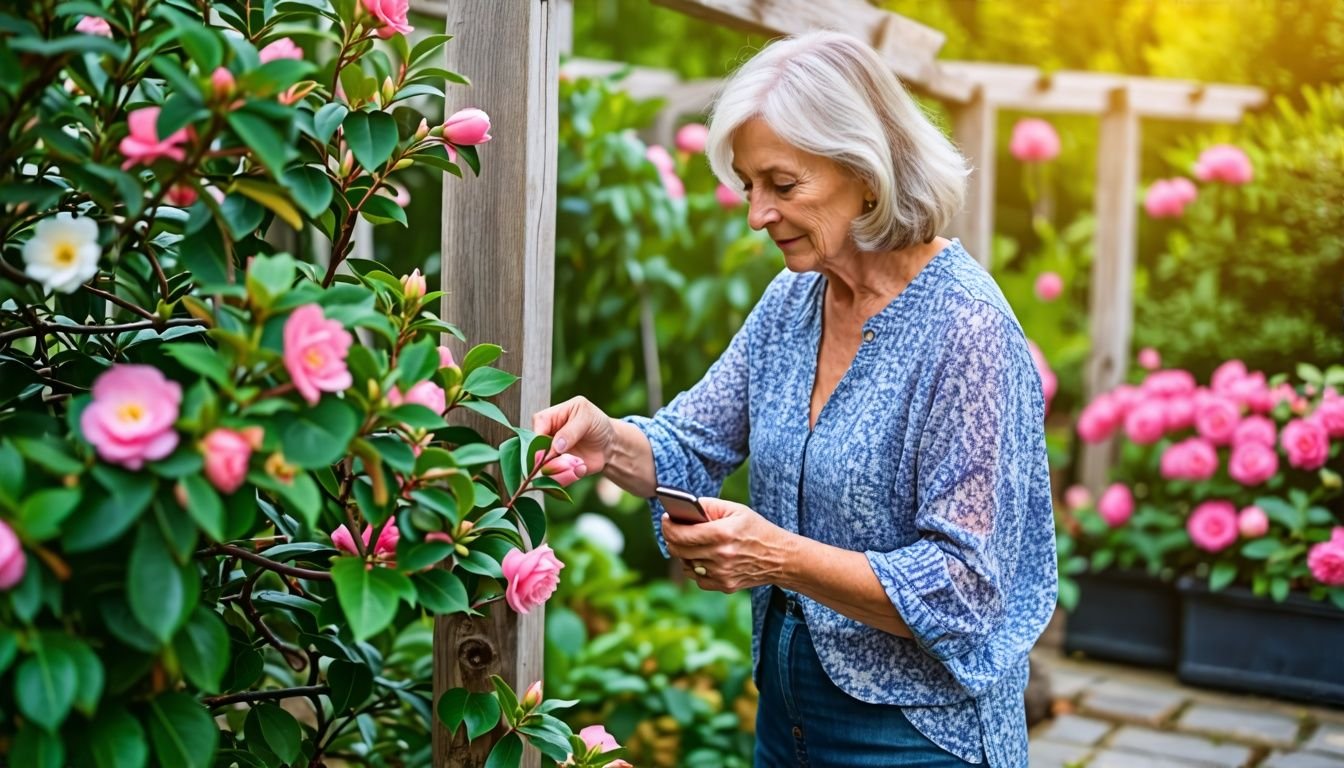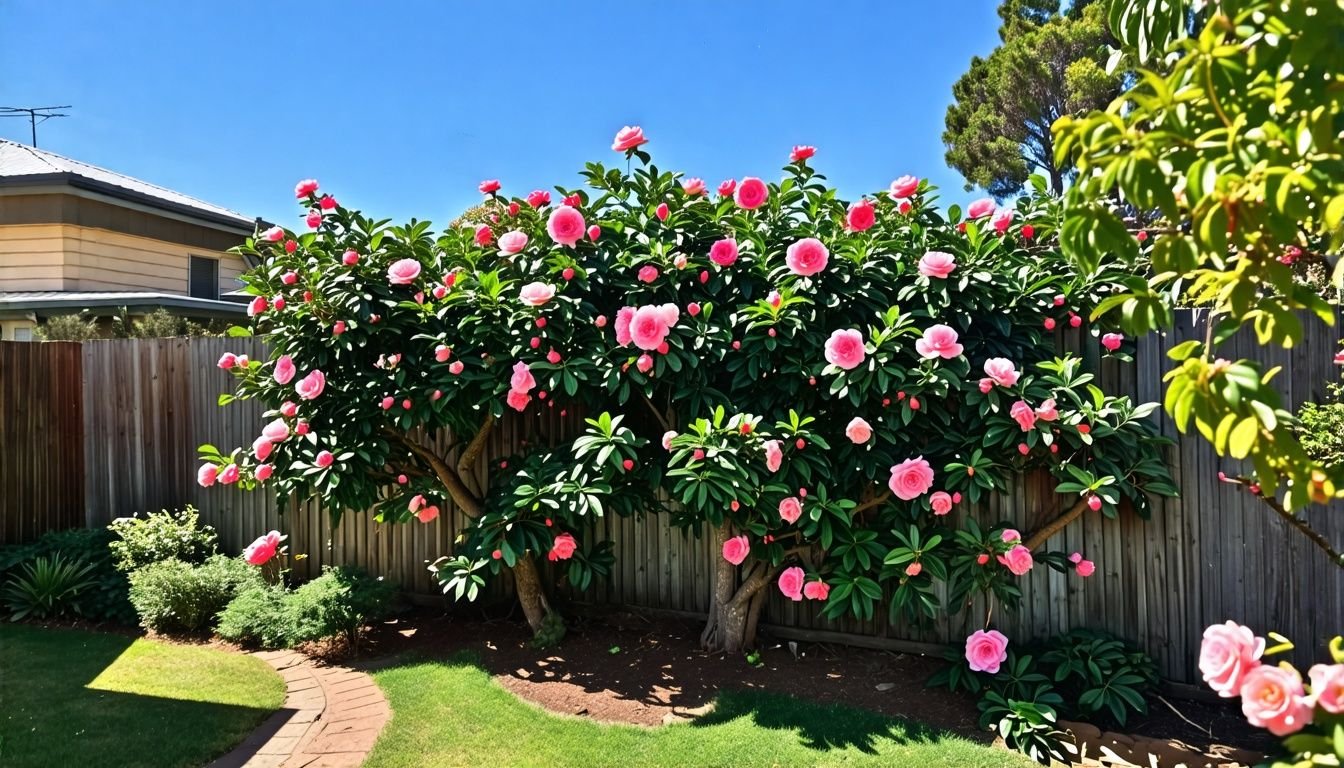Espalier camellias can turn a plain garden wall into a living work of art. But let’s be honest, many Aussie gardeners get a bit nervous about training these beautiful shrubs. They reckon it’s too hard or time-consuming.
Fair enough, we’ve had those same doubts ourselves.
We’ve wrestled with the idea of espalier camellias too, mate. That’s why we rolled up our sleeves and really dug into this ancient gardening technique. Did you know camellias are ace for espaliering due to their lush evergreen foliage and stunning flowers? We’ll show you how to grow these beauties flat against a wall or fence.
It’s not nearly as tricky as you might think!
Our guide will walk you through picking the right camellia varieties, setting up your structure, and getting the hang of pruning techniques. We’ll also share some ripper tips for tackling common challenges.
Keen to give your garden a facelift? Let’s get cracking!
Key Takeaways
- Camellia Sasanqua and Japonica varieties work well for espalier, with prices ranging from $39 to $495 depending on size and type.
- Popular espalier designs include V-shaped, Belgian fence, horizontal T, and fan styles, adapted from French fruit tree techniques.
- Set up a support structure with posts 60-90 cm from the wall and wires at least 60 cm above ground, using soft ties every 20 cm to secure branches.
- Prune regularly after flowering, feed in late winter with balanced fertiliser, and maintain air flow to prevent fungal issues.
- Espalier camellias can transform small spaces, create elegant focal points in traditional gardens, or add cottage charm when mixed varieties are used.
Selecting the Right Camellia Varieties for Espalier

We’ll help you pick the best camellias for espalier. Sasanqua and Japonica types both work well, but they have different traits to consider.
Camellia Sasanqua Varieties
Camellia Sasanqua varieties offer stunning options for espalier in Australian gardens. These plants thrive in full sun and flower from autumn to winter, adding colour to our outdoor spaces.
Popular choices include Hiryu, Paradise Blush, and Setsugekka, each bringing unique charm to narrow beds and small gardens.
Our range of Camellia Sasanqua plants starts at $39.00 and goes up to $295.00, depending on size and type. Early Pearly is another favourite that fits well in planters, making it perfect for tight spots.
Pot sizes vary, with prices ranging from $175.00 to $495.00 for larger specimens.
Camellia Sasanquas are the winter jewels of the Australian garden.
These hardy plants adapt well to espalier techniques, forming beautiful living fences or wall covers. Their fast growth and dense foliage make them ideal for creating privacy screens or decorative features.
With proper care and pruning, Camellia Sasanquas can transform any garden into a winter wonderland.
Camellia Japonica Varieties
We love Camellia Japonica varieties for their stunning blooms and versatility in Australian gardens. These beauties offer a range of colours and forms, perfect for espalier training.
Popular choices include Brushfields Yellow, Pinktastic, Roger Hall, and Volunteer. Each variety brings its own charm to your outdoor space.
Our favourite Japonica camellias flower from autumn to winter, adding colour to your garden when it needs it most. They thrive in partial sun, shady, or filtered light areas, making them ideal for many spots in your yard.
We’ve found they grow well in pots too, as long as you give them enough room to spread their roots.
You’ll find these lovely plants available in various sizes to suit your needs. Pot sizes range from 25cm to 50cm, with prices between $175 and $495. Whether you’re after a small accent plant or a larger specimen for a bold statement, there’s a Camellia Japonica variety that’s just right for your garden design.
Steps to Espalier Camellias
We’ll guide you through the steps to create your own espalier camellia. Our tips will help you choose a design and build a strong structure for your plant to grow on.
Choosing Your Espalier Design
Choosing the right espalier design for our camellias is exciting. We have many options to pick from, like V-shaped, Belgian fence, horizontal T, and fan designs. These styles come from France, where gardeners first used them on pear and apple trees.
Now, we can use them to make our camellia sasanquas look stunning.
Our choice depends on the space we have and the look we want. Formal designs create specific shapes, while informal ones let the plant grow more naturally. Both types can turn dull walls into eye-catching features.
For small Aussie gardens, espalier is perfect. It helps us grow beautiful camellias without taking up too much room. Let’s explore how to build the structure for our chosen design.
Espalier is the art of turning a simple plant into a living sculpture.
Constructing Your Espalier Structure
We’ll need to set up a strong support system for our espalier camellias. Our first step involves placing posts 60-90 cm away from the wall. These posts form the backbone of our structure.
Next, we string wires between the posts. The bottom wire should sit at least 60 cm above the ground. This setup gives our camellias room to grow and spread.
For those who prefer a different look, lattice offers a great alternative to wires. It provides a solid surface for our camellias to lean against. Once we’ve got our structure in place, we use soft plastic ties or twine to secure the branches.
We place these ties about every 20 cm along the branches. This spacing helps us shape our espalier without damaging the plant.
Our structure now stands ready for our camellias. The next crucial step in our espalier journey focuses on planting and pruning techniques.
Planting and Pruning Techniques for Espalier Camellias
Planting and pruning espaliered camellias requires careful attention to detail. We’ve compiled a list of essential techniques to help you grow stunning espalier camellias in your Australian garden.
- Planting:
- Choose a spot close to a wire or trellis for support.
- Allow 2-3 months for recovery after transplanting.
- Tie the main stem to encourage straight growth.
- Initial Training:
- Spread and tie branches along the first wire of the trellis.
- Remove lower branches to maintain the desired shape.
- Use soft ties to avoid damaging the bark.
- Pruning Schedule:
- Prune regularly to keep a flat, two-dimensional look.
- Delay major pruning until after the flowering season.
- Trim new growth to maintain the espalier form.
- Pruning Technique:
- Cut back to just above a leaf or bud.
- Remove any inward-growing or crossing branches.
- Thin out dense areas to improve air circulation.
- Fertilising:
- Feed in late winter or early spring.
- Use a balanced fertiliser for acid-loving plants.
- Apply around the drip line, not directly at the base.
- Shaping:
- Train new growth along the wires as it appears.
- Pinch out growing tips to encourage branching.
- Adjust ties as the branches thicken to prevent girdling.
- Maintenance:
- Check ties regularly and loosen if needed.
- Remove any dead or diseased wood promptly.
- Water deeply during dry spells, especially for newly planted camellias.
Common Challenges and Solutions in Espalier Camellia Cultivation
Growing espalier camellias can be tricky, but we’ve got some tips to help. One big issue is poor air flow when plants grow against walls. This can lead to fungal problems. We solve this by adding lattice or guide wires to create space between the wall and the plant.
This extra room lets air move freely, keeping our camellias healthy.
Another challenge is managing plant growth as it matures. Ties used to train branches can become too tight over time. We check and loosen these ties regularly to prevent damage to the bark.
For camellias in pots, we keep a close eye on water levels. Pots dry out faster than garden beds, so we water more often to keep our plants happy.
Feeding espalier camellias needs care too. We use a balanced fertiliser made for acid-loving plants. It’s easy to over-feed, which can harm the plant. By following the product instructions, we give our camellias just what they need to thrive.
With these steps, we can grow beautiful espalier camellias that add charm to any Aussie garden.
Inspirational Ideas for Integrating Espalier Camellias in Garden Design
Now that we’ve tackled common challenges, let’s explore exciting ways to use espalier camellias in our gardens. We love how these plants can transform dull walls and austere fences into stunning features.
For city and courtyard gardens, espalier camellias offer a space-saving solution with big impact. We can train Camellia sasanqua varieties like ‘Hiryu’ or ‘Paradise Blush’ into lattice structures for vertical growth.
These winter-flowering beauties add colour and life to narrow garden beds or small balconies.
In traditional or Japanese-style gardens, espalier camellias create elegant focal points. We often use Camellia japonica varieties such as ‘Brushfields Yellow’ or ‘Roger Hall’ for their showy blooms.
These plants, expertly pruned into fan or diamond shapes, can frame doorways or line pathways. For a cottage garden feel, we mix different camellia varieties in a single espalier design.
This approach gives us a longer blooming period and a rich tapestry of colours, from soft pinks to deep reds.
Conclusion
Espalier camellias bring timeless charm to Aussie gardens. We’ve shown you how to choose, plant, and train these beauties. With care and patience, you’ll create stunning living walls of glossy leaves and vibrant blooms.
Your espalier camellias will become the envy of the neighbourhood. They’ll add a touch of elegance to any outdoor space, big or small.
FAQs
1. What is a camellia sasanqua espalier and how does it differ from a red rose?
A camellia sasanqua espalier is a winter flowering shrub trained to grow flat against a wall or fence. Unlike a red rose, it blooms in cooler months and has a more compact growth habit.
2. How do I choose the right planter for my espalier camellia?
Select a planter that can support the mature size of your camellia sasanqua espalier. Ensure it has good drainage and enough space for root growth. Many nurseries offer fast shipping on suitable planters.
3. When is the best time to add camellia sasanqua espaliers to my garden?
The ideal time to add these plants to your cart or quote is in early autumn. This gives them time to establish before their winter flowering period. Many Australian nurseries offer online ordering for convenience.
4. How long does it take for a camellia sasanqua espalier to reach its mature size?
With proper care and training, a camellia sasanqua espalier can reach its mature size in 3-5 years. Regular pruning and shaping will help maintain its form and encourage dense growth.
